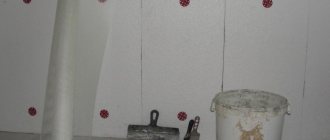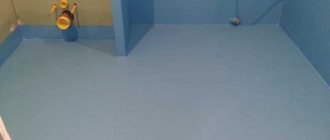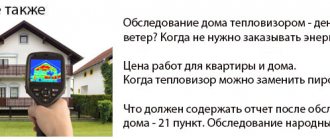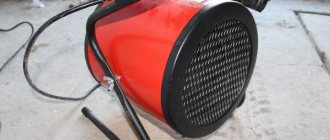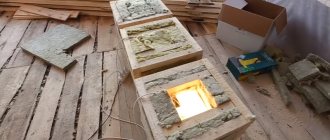Article navigation:
>
High-quality insulation for sandwich panels allows not only to ensure a sufficient level of thermal insulation, but also to give the panels additional properties, such as non-flammability, resistance to the influence of fungus and pests, etc. That is why many manufacturers carefully select and test the properties of finished panels for each type insulation. The use of a specific type of thermal insulation allows you to largely determine the thickness of the panels, since they have different thermal conductivity coefficients.
1.1. Metal cladding
The cladding is galvanized steel sheet with a protective and decorative paint coating in accordance with GOST 14918-80, GOST R 52246-2004.
When renting sandwich panels, the standard metal thickness is 0.5 mm. On request, it is possible to use steel sheets with a thickness of 0.45 mm, 0.6 mm, 0.7 mm.
Table 1. Technical characteristics of steel for sandwich panels.
| Characteristic | Meaning |
| Yield strength, not less | 280 MPa |
| Temporary tensile strength, not less | 360 MPa |
| Relative elongation, not less | 35,0% |
| Total mass of zinc coating on 2 sides, not less, GOST R 52146-2003 | 1st class of coating – from 258 g/sq.m. 2nd class of coating – from 140 g/sq.m. |
| Average thickness of zinc coating, not less, GOST R 52146-2003 | 1st class of coating - from 38.1 microns 2nd class of coating - from 21.6 microns |
| Standard width of steel sheet | 1250 mm |
| Steel sheet thickness | From 0.5 mm |
Types of panels

- dimensions - depends on the size of the prefabricated structure;
- types of profiling and cladding material;
- installation methods;
- double-sided or single-sided cladding;
- type of fastener - open or closed - a closed lock retains heat better;
- a type of polymer coating for the casing;
- purpose of the material.
The choice of products depends on many factors, so it is necessary to contact professionals who are licensed to work with this type of material.

By purpose
The purpose of the panels can be of two types - roofing and wall . They are manufactured for warm and northern regions, heated and unheated buildings, residential and non-residential.
By type of polymer coating
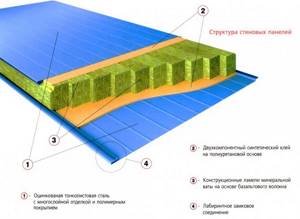
- Polyvinyl chloride is a film coating that is recommended for wet rooms. Also suitable for buildings whose interiors are frequently cleaned, such as pharmaceutical drug manufacturing companies.
- Polyester – designed for buildings with normal requirements.
- Polyurethane Pural . It has increased resistance to corrosion and aggressive chemicals.
- Polyurethane Pural Pharm . The most resistant coating, including fading and ultraviolet resistance.
- Polyvinyl dichloride - coating is recommended for facades located on the sunny side.
In pharmaceutical and food industry buildings, stainless steel as the only possible option to comply with the requirements of the sanitary and epidemiological station. In terms of cost, this is more expensive.
Galvanized steel coated with a polymer material is the best option for all types of buildings that do not have any special requirements. In turn, there are requirements for the grade of steel and the thickness of the galvanizing layer. For the steel grade, the yield strength is important - from 280 to 350 MPa. Unless the steel is structural, it should not be used in the manufacture of panels. Unscrupulous manufacturers use non-structural steel to reduce the cost of products.
By type of cladding
The outer skin varies in thickness - from 0.4 to 0.7 mm. The external effect depends on the quality of the steel and its thickness - the wall will appear smoother. For interior walls, steel with a thickness of 0.4 to 0.7 mm can be used.
In addition to steel, other materials that are less strong and durable can be used for cladding. Some of them require additional coating to withstand precipitation.
Cost of sandwich panels
1.2. Polymer coatings
Structure of steel sheet with polymer coating:
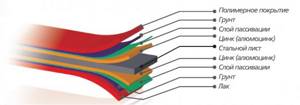
Types of coatings:
Polyester – polyester coating. Suitable for external and internal work. Resistant to weathering and corrosion. Suitable for all climate zones.
Coating thickness - 25 microns.
Pural – polyurethane coating. It is practically not subject to mechanical stress, ultraviolet radiation, or chemically active components, which ensures a long service life, does not lose color, and the integrity of the coating. Coating thickness 25 microns. Suitable for external and internal work.
PVDF – polyvinyl difluoride coating. The coating consists of 80% polyvinyl fluoride and 20% acrylic. Advantages of the coating: high anti-corrosion properties, resistance to weathering and pollution, suitable for outdoor use in any conditions. Retains its properties in the temperature range from -60°C to +120°C and has good ductility.
Plastisol (PVS) – polyvinyl chloride coating. It has excellent ductility and is resistant to scratches, corrosion and environmental influences. Recommended for use in harsh operating conditions and polluted environments. In addition, Plastisol can significantly improve the appearance of the facade. Coating thickness 200 microns.
Table 2. Types of polymer coatings for metal skins of sandwich panels.
| Coating/characteristic | Polyester | Pural | PVDF | Plastisol |
| Coating thickness, microns | 25 | 50 | 25 | 175/200 |
| Surface | smooth | smooth | smooth | embossing |
| Maximum operating temperature, °C | 120 | 120 | 120 | 60 |
| Minimum operating temperature, °C | -10 | -15 | -10 | +10 |
| Preservation of appearance | ** | **** | ***** | *** |
| Minimum bend radius | 3xt | 1xt | 1xt | 0xt |
| Salt test, h | 500 | 1000 | 1000 | 1000 |
| Water test, h | 1000 | 1000 | 1000 | 1000 |
| UV resistance | **** | **** | ***** | *** |
| Resistance to mechanical damage | *** | **** | ***** | ***** |
Expanded polystyrene
Expanded polystyrene as insulation for sandwich panels is an almost ideal material. It protects the panels from various chemical and biological influences, is environmentally friendly and has maximum thermal insulation properties when compared with other materials. Due to its cellular structure, its weight is minimal, which makes it possible to produce panels with low weight that do not load the foundation. Expanded polystyrene is resistant to moisture and does not promote the development of bacteria and mold.
Among the disadvantages are its high flammability and high requirements for the evenness of the surface of the base for its installation due to fragility. During installation, it is demanding on the quality of sealing joints with special tape.
1.3. Color solutions
Standard colors according to the RAL catalog used in the production of SteelPanel, Polyester coating:
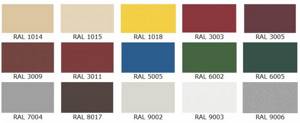
It is possible to produce sandwich panels in non-standard colors. When choosing non-standard colors, metal painting is carried out to order, which increases the delivery time of sandwich panels.
When choosing a color scheme, you need to take into account that darker colors are more susceptible to surface heating, which can lead to thermal deformations (swelling of the skins between fastenings, the formation of folds on the metal at fastening points). When choosing dark colors, it is not recommended to use a three-span fastening scheme.
At the same time, light colors have greater reflectivity. Light surfaces are not subject to overheating, which preserves the surface of the sandwich panel in its original form.
1.4. Insulation materials
Metal sandwich panels are produced with two types of insulation: basalt mineral wool and expanded polystyrene.
Basalt mineral wool is a thermal insulation material based on basalt, also called stone wool. Cotton wool has a fibrous structure, so the spaces between the fibers are filled with air and provide high thermal insulation characteristics.
To ensure rigidity, sandwich panels use so-called lamellas. The mineral wool slab is cut into strips of the required width and unfolded when fed into a line perpendicular to the metal casings (cladding). Due to this direction of the wool fibers, the required compressive strength of the finished sandwich panel is achieved.
The main advantages of mineral wool are low thermal conductivity, environmental friendliness, flammability group NG, and resistance to chemical influences.
Table 3. Thermophysical and mechanical properties of basalt mineral wool.
| Name | Index |
| Density, kg/cub.m, not less | 110 (±10%) |
| Thermal conductivity, W/mK, no more | 0,044 |
| Water absorption by volume, %, no more | 1,5 |
| Content of organic substances by weight, %, no more | 4,5 |
| Compressive strength at 10% deformation, kPa, not less | 60 |
| Adhesion strength (layer separation), kPa, not less | 100 |
| Shear/shear strength, kPa, not less | 50 |
| Vapor permeability mg/(m h Pa), not less | 0,53 |
| Flammability group | NG |
Expanded polystyrene is a thermal insulation material based on styrene. Produced by foaming (filling with air) styrene granules. Due to good air filling, it has high thermal insulation characteristics. It is light in weight but has fairly good rigidity.
In sandwich panels, expanded polystyrene is laid in ready-made sheets, the sheets are pressed tightly.
The main advantages of expanded polystyrene are moisture resistance, low thermal conductivity, environmental friendliness, and when treated with a fire retardant, it can be classified as low-flammable (group P).
Table 4. Thermophysical and mechanical properties of polystyrene foam.
| Name | Index |
| Density, kg/cub.m, not less | 13,5 |
| Thermal conductivity, W/mK, no more | 0,039 |
| Water absorption by volume, %, no more | 2 |
| Self-combustion time, s, no more | 4 |
| Compressive strength at 10% deformation, mPa, not less | 0,1 |
| Bending strength, mPa, not less | 0,18 |
| Humidity, %, no more | 12 |
All insulation materials used in the production of sandwich panels are certified and do not pose a danger to humans and the environment.
Dew point in a garage made of sandwich panels
There is one important nuance that those who plan to build something from sandwich panels, for example, a garage, should know about. The fact is that even the excellent thermal insulation characteristics of sandwich panels do not negate the laws of physics, and like any other material they are sensitive to the location of the dew point.
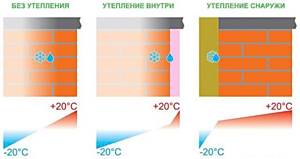
Dew point in a brick wall
Many owners of garages and other buildings made of sandwich panels are surprised to find condensation on the walls. This happens when the dew point is on the inner surface of the walls of the object. In this case, water droplets appear on the walls. And it doesn’t matter what the walls are made of - sandwich panels, bricks or wood. By the way, the thermal insulation of sandwich panels (expanded polystyrene, polyurethane foam) is not afraid of the formation of condensation inside the panel, since in the closed cavities of the insulation there is simply not enough moisture for this. But the formation of condensation on the surface of the panel is undesirable.
Avoiding condensation is easy. But this is the topic of our next article.
1.6. Protective mounting film
To protect the polymer coating from light mechanical damage (scratches) during transportation, loading and unloading, installation, a protective mounting film is applied to the surface of the sandwich panels. After completing the installation work, the film is removed.
IMPORTANT! Instructions for using protective film:
1. Protective film is designed to protect surfaces from damage and contamination during transportation and installation, as well as from mechanical stress during processing (bending, cutting, shaping, stamping)
2. All declared technical characteristics of the protective film are valid in the range of 20 degrees Celsius. This temperature is mandatory both for the film itself and for the surface to be coated at the time of application. The optimal storage temperature is 15-30°C.
3. If the film is exposed to unfavorable conditions for a long time (temperature changes in a range other than operating ones; aggressive environment, etc.), its properties may be lost.
4. Surface treatment with all types of solvents is not allowed.
5. The film is applied under production conditions and removed immediately after installation of the product.
6. Storing surfaces with applied film in direct sunlight is unacceptable, because may cause changes in the properties of the adhesive, which will lead to difficulties when removing the film from the product.
7. To ensure that no fragments of the protective film or adhesive remain on the surface, the film must not be removed at very low (not lower than -10°C) or very high air temperatures (not higher than 40°C).
8. The shelf life of products with applied film is no more than 1 month.
9. All stated requirements are recommended by the manufacturer of this type of film.
Attention!
If the conditions for storing and using the protective film have been violated and the film is difficult to peel off, you can locally, at a temperature of approximately 60 degrees, quietly use a technical hair dryer. If the film has been on the product for a long time, and after its removal there is glue left, then it can be removed with industrial alcohol, but in no case with a solvent.
When using a solvent, not only the protective film is damaged, but also the polymer surface of the sandwich panel.
Polyurethane foam
Foamed polyurethane has all the advantages of expanded polystyrene, but has better hydro- and thermal insulation properties due to its porous structure with a number of closed pores of 99%. Its structure is homogeneous and uniform, due to which the thermal conductivity coefficient is the same at any point of the insulated surface. Minimum weight and high strength make it resistant to mechanical stress without destruction or loss of properties. It is applied in the form of foam to the surface in an even layer and hardens under the influence of air, or laid in panels. The disadvantage of polyurethane foam is its increased flammability.
2.1. Characteristics tables
Table 5. Characteristics of wall sandwich panels with mineral wool insulation.
| Sandwich panel thickness, mm | 50 | 60 | 80 | 100 | 120 | 150 | 180 | 200 | 250 |
| Specific gravity, kg/sq.m | 14,4 | 15,6 | 17,9 | 20,2 | 22,2 | 26,0 | 29,8 | 31,7 | 37,5 |
| Reduced heat transfer resistance, sq.m°C/W | 1,16 | 1,4 | 1,86 | 2,33 | 2,79 | 3,49 | 4,19 | 4,65 | 5,81 |
| Thermal conductivity of insulation, W/m°C | λcalc=0.041 | ||||||||
| Fire resistance values | EI 30 | EI 30 | EI 45 | EI 90 | EI 150 | EI 150 | EI 150 | EI 150 | EI 150 |
Table 6. Characteristics of roofing sandwich panels with mineral wool insulation.
| Sandwich panel thickness, mm | 60 | 80 | 100 | 120 | 150 | 180 | 200 | 250 |
| Specific gravity, kg/sq.m | 15,6 | 17,9 | 20,2 | 22,2 | 26,0 | 29,8 | 31,7 | 37,5 |
| Reduced heat transfer resistance, sq.m°C/W | 1,4 | 1,86 | 2,33 | 2,79 | 3,49 | 4,19 | 4,65 | 5,81 |
| Thermal conductivity of insulation, W/m°C | λcalc=0.041 | |||||||
| Fire resistance values | REI 30 | REI 45 | ||||||
Table 7. Characteristics of wall sandwich panels with polystyrene foam insulation.
| Sandwich panel thickness, mm | 50 | 60 | 80 | 100 | 120 | 150 | 180 | 200 | 250 |
| Specific gravity, kg/sq.m | 9,4 | 9,6 | 9,9 | 10,2 | 10,5 | 10,95 | 11,22 | 11,7 | 12,45 |
| Reduced heat transfer resistance, sq.m°C/W | 1,28 | 1,54 | 2,05 | 2,56 | 3,08 | 3,85 | 4,62 | 5,13 | 6,41 |
| Thermal conductivity of insulation, W/m°C | λcalc=0.039 | ||||||||
| Fire resistance values | EI 15 | ||||||||
Table 8. Characteristics of roofing sandwich panels with polystyrene foam insulation.
| Sandwich panel thickness, mm | 60 | 80 | 100 | 120 | 150 | 180 | 200 | 250 |
| Specific gravity, kg/sq.m | 10,6 | 10,8 | 11,4 | 11,7 | 12,1 | 12,4 | 12,9 | 13,6 |
| Reduced heat transfer resistance, sq.m°C/W | 1,54 | 2,05 | 2,56 | 3,08 | 3,85 | 4,62 | 5,13 | 6,41 |
| Thermal conductivity of insulation, W/m°C | λcalc=0.039 | |||||||
| Fire resistance values | REI 15 | |||||||
Sound insulation and fire resistance of sandwich panels
Just like with weight, the soundproofing properties of the panels depend on the insulation used and the thickness. It is for this reason that the choice of insulation should be based on fire safety requirements based on the purpose of the building. For example, retail pavilions, residential and administrative, prefabricated buildings are built only from panels with mineral wool insulation, while polyurethane foam or polyisocyanurate foam is used in the construction of refrigerators and freezers. Of course, you should definitely take into account the economic feasibility in terms of price-quality ratio. The table below shows the characteristics of the panels taking into account different types of insulation.
With mineral wool insulation
| Thickness, mm | Thermal resistance Rt=m2×°C/W | Sound insulation, dB | Thermal conductivity λ=W/Mk | Fire resistance limit | Flammability of insulation | Density, kg/m3 |
| 50 | 1,04 | 30 | 0,05 | EI 30 | NG | 120-140 |
| 80 | 1,67 | 31 | 0,05 | EI 45 | NG | 120-140 |
| 100 | 2,08 | 32 | 0,05 | EI 90 | NG | 120-140 |
| 120 | 2,5 | 33 | 0,05 | EI 150 | NG | 120-140 |
| 150 | 3,13 | 35 | 0,05 | EI 180 | NG | 120-140 |
| 200 | 4,14 | 38 | 0,05 | EI 180 | NG | 120-140 |
| 250 | 5,21 | 43 | 0,05 | EI 180 | NG | 120-140 |
With polystyrene foam insulation
| Thickness, mm | Thermal resistance Rt=m2×°C/W | Sound insulation, dB | Thermal conductivity λ=W/Mk | Fire resistance limit | Flammability of insulation | Density, kg/m3 |
| 50 | 1,28 | 25 | 0,042 | EI 15 | G1 | 25 |
| 80 | 2,05 | 28 | 0,042 | EI 15 | G1 | 25 |
| 100 | 2,56 | 29 | 0,042 | EI 15 | G1 | 25 |
| 120 | 3,08 | 31 | 0,042 | EI 15 | G1 | 25 |
| 150 | 3,85 | 33 | 0,042 | EI 15 | G1 | 25 |
| 200 | 5,13 | 35 | 0,042 | EI 15 | G1 | 25 |
| 250 | 6,41 | 39 | 0,042 | EI 15 | G1 | 25 |
With polyurethane foam/polyisocyanurate foam insulation
| Thickness, mm | Thermal resistance Rt=m2×°C/W | Sound insulation, dB | Thermal conductivity λ=W/Mk | Fire resistance limit | Flammability of insulation | Density, kg/m3 |
| 50 | 2,38 | 30 | 0,022 | EI 15/EI 15 | G4/G2 | 41 |
| 80 | 3,81 | 31 | 0,022 | EI 15/EI 30 | G4/G2 | 41 |
| 100 | 4,76 | 32 | 0,022 | EI 15/EI 30 | G4/G2 | 41 |
| 120 | 5,71 | 33 | 0,022 | EI 15/EI 30 | G4/G2 | 41 |
| 150 | 7,14 | 35 | 0,022 | EI 15/EI 45 | G4/G2 | 41 |
| 200 | 9,52 | 35 | 0,022 | EI 15/EI 45 | G4/G2 | 41 |
2.2. Soundproofing
Table 9. Sound insulation characteristics of wall and roof sandwich panels with mineral wool insulation.
| Sandwich panel thickness, mm | Rw (wall panels), dB | Ra (wall panels), dB | Ra (roofing panels), db |
| 50 | 32 | 29 | — |
| 80 | 32 | 29 | — |
| 100 | 35 | 30 | 31 |
| 120 | 35 | 30 | 31 |
| 150 | 35 | 30 | 32 |
| 200 | 35 | 30 | — |
Rw – airborne noise insulation, is a standardized parameter for the sound insulation of internal enclosing structures of residential and public buildings, as well as auxiliary buildings of industrial enterprises.
Ra – which represents the insulation of external noise produced by the flow of urban traffic, is a standardized parameter for the sound insulation of external enclosing structures.
Standardized parameters are regulated:
— SP 51.13330.2011 “Protection from noise”,
— SNiP 03/23/2003 “Protection from noise”,
— SP 23-103-2003 “Design of sound insulation of enclosing structures of residential and public buildings”,
— GOST 27296-87 (ST SEV 4866-84) “Noise protection in construction. Sound insulation of enclosing structures. Measurement methods".
Nuances of choosing thermal insulation
The main indicator of insulation is the thermal conductivity coefficient, which reflects the ability of materials to conduct heat in quantitative terms. The lower its value, the better the thermal insulation properties. In addition, insulation for sandwich panels must:
- have little weight;
- be durable, environmentally friendly, resistant to climate, moisture and temperature changes;
- withstand significant loads;
- save your settings throughout the entire period of use.
Before buying a sandwich panel , you need to inquire about the operating conditions. Depending on the purpose of the buildings being constructed, insulation with a certain fire resistance limit is selected. An equally important criterion for choosing a thermal insulation material is its cost, which has a significant impact on the overall costs of constructing construction projects. Mineral wool and expanded polystyrene are most often used as insulation for sandwich panels. They differ in structure, manufacturing technology and technical characteristics. The production of sandwich panels is carried out under strict control with strict adherence to manufacturing technology. Manufactured products comply with fire safety requirements, which were confirmed during testing of full-scale samples. As a result of the studies, indicators of the fire resistance limits of insulation were obtained. Depending on the thickness of the products, they are:
- for roofing panels - REI 30;
- for wall panels - EI 30-EI 150.
2.3. Load bearing capacity
Bearing capacity is the maximum load without loss of functional qualities that a structure, its elements, as well as foundation soils can bear.
The load-bearing capacity was calculated in accordance with SP 20.13330.2011 “Loads and impacts”.
Wall sandwich panels
Calculations of the load-bearing capacity of wall sandwich panels take into account that tightly glued insulation helps distribute stress under loads and absorbs shear forces, while metal sheathing is subject to tension and compression.
The calculation does not take into account possible changes in the shape of the panels (cutouts, cut edges, etc.). Limit states of load-bearing capacity have been calculated for wall panels. The values indicated in the tables are reference material and must be calculated when carrying out design work.
Calculations were carried out taking into account the following simplifications and assumptions:
— the thickness of the sandwich panel is indicated by the thickness of the insulation,
— thickness of metal casings 0.6 mm,
— the width of external supports is at least 40 mm,
— the width of the internal supports is at least 70 mm,
— permissible deflection of the panel 1/100 L span,
— when determining the maximum deflection, the temperature difference between the outer and inner metal cladding t=55°C is taken into account.
Table 10. Design load-bearing capacity of wall sandwich panels with mineral wool.
| Panel thickness, mm | Load-bearing capacity of wall sandwich panels with a uniformly distributed load, kg/sq.m | ||||||||
| Span length, m | |||||||||
| 3,0 | 3,5 | 4,0 | 4,5 | 5,0 | 5,5 | 6,0 | 6,5 | 7,0 | |
| 50 | 80 | 60 | 37 | 21 | 11 | — | — | — | — |
| 80 | 135 | 115 | 98 | 79 | 67 | 48 | 35 | 25 | 14 |
| 100 | 155 | 136 | 115 | 94 | 76 | 58 | 46 | 34 | 28 |
| 120 | 201 | 174 | 145 | 125 | 104 | 85 | 68 | 57 | 46 |
| 150 | 215 | 190 | 168 | 143 | 121 | 101 | 85 | 71 | 59 |
| 200 | 268 | 236 | 208 | 180 | 156 | 134 | 115 | 98 | 84 |
Fig.1. Graph of the load-bearing capacity of wall sandwich panels with mineral wool under a uniformly distributed load. The loading scheme is single-span.
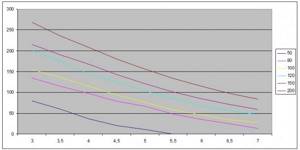
Table 11. Calculated load-bearing capacity of wall sandwich panels with expanded polystyrene.
| Panel thickness, mm | Load-bearing capacity of wall sandwich panels with a uniformly distributed load, kg/sq.m | ||||||||
| Span length, m | |||||||||
| 3,0 | 3,5 | 4,0 | 4,5 | 5,0 | 5,5 | 6,0 | 6,5 | 7,0 | |
| 50 | 103 | 74 | 48 | 28 | 14 | — | — | — | — |
| 80 | 167 | 141 | 123 | 94 | 77 | 58 | 42 | 29 | 15 |
| 100 | 191 | 165 | 141 | 117 | 96 | 71 | 55 | 41 | 36 |
| 120 | 248 | 214 | 182 | 157 | 132 | 103 | 81 | 71 | 54 |
| 150 | 264 | 237 | 207 | 175 | 150 | 126 | 104 | 85 | 71 |
| 200 | 329 | 296 | 257 | 221 | 192 | 163 | 143 | 120 | 103 |
Fig.2. Graph of the load-bearing capacity of wall sandwich panels with expanded polystyrene under a uniformly distributed load. The loading scheme is single-span.
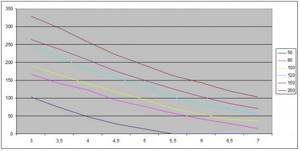
Mineral wool: characteristics and properties
In accordance with the provisions of GOST R 52953-2008, the raw materials for the production of mineral wool can be molten rocks, blast furnace slag and fiberglass. A material consisting of fibers obtained from molten stone mass is used as insulation. Depending on the location of the layers, thermal insulation is distinguished with a spatial, horizontal or vertical structure.
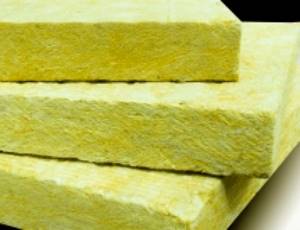
- low thermal conductivity coefficient;
- long service life of 30-40 years;
- the ability to maintain its parameters when heated or cooled and withstand up to +1000 ° C;
- resistance to mechanical damage and aggressive chemicals;
- high tensile strength.
The moisture absorption coefficient of mineral wool is determined by the method of its manufacture. The value of the material produced using modern technologies is 1-2%. Mineral wool is not susceptible to rotting, mold or mildew and is not deformed by rodents. Sandwich panels with mineral wool are used in the construction of prefabricated buildings for various purposes. They are especially in demand during the construction of objects whose load-bearing fences are subject to increased fire resistance requirements. Mineral wool is a non-flammable material, so when using it there is no risk of ignition.
Roof sandwich panels
Calculations of the load-bearing capacity of wall sandwich panels take into account that tightly glued insulation helps distribute stress under loads and absorbs shear forces, while metal sheathing is subject to tension and compression.
The calculation does not take into account possible changes in the shape of the panels (cutouts, cut edges, etc.). Limit states of load-bearing capacity have been calculated for wall panels. The values indicated in the tables are reference material and must be calculated when carrying out design work.
Calculations were carried out taking into account the following simplifications and assumptions:
— the thickness of the sandwich panel is indicated by the thickness of the insulation,
— thickness of metal casings 0.6 mm,
— the width of external supports is at least 60 mm,
— the width of the internal supports is at least 80 mm,
— permissible deflection of the panel 1/100 L span,
— the calculation takes into account the panels’ own weight and a concentrated load of 100 kgf in the middle of the span
Table 12. Design load-bearing capacity of roofing sandwich panels with mineral wool
| Panel thickness, mm | Load-bearing capacity of roofing sandwich panels with a uniformly distributed load, kg/sq.m | |||||
| Span length, m | ||||||
| 1,5 | 2,0 | 2,5 | 3,0 | 3,5 | 4,0 | |
| 60 | 151 | 106 | 65 | 33 | 15 | — |
| 80 | 206 | 135 | 98 | 73 | 55 | 37 |
| 100 | 285 | 195 | 141 | 108 | 88 | 64 |
| 120 | 354 | 248 | 187 | 145 | 117 | 91 |
| 150 | 440 | 336 | 255 | 204 | 160 | 136 |
| 200 | 609 | 433 | 334 | 270 | 224 | 189 |
Fig.3. Graph of the load-bearing capacity of roofing sandwich panels with mineral wool under a uniformly distributed load. The loading scheme is single-span.
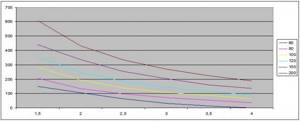
Table 13. Design load-bearing capacity of roofing sandwich panels with expanded polystyrene foam
| Panel thickness, mm | Load-bearing capacity of roofing sandwich panels with a uniformly distributed load, kg/sq.m | |||||
| Span length, m | ||||||
| 1,5 | 2,0 | 2,5 | 3,0 | 3,5 | 4,0 | |
| 60 | 184 | 134 | 84 | 48 | 25 | — |
| 80 | 249 | 161 | 121 | 93 | 71 | 52 |
| 100 | 345 | 237 | 172 | 131 | 107 | 83 |
| 120 | 429 | 298 | 225 | 174 | 139 | 112 |
| 150 | 540 | 405 | 306 | 243 | 193 | 161 |
| 200 | 738 | 522 | 399 | 319 | 265 | 220 |
Fig.4. Graph of the load-bearing capacity of roofing sandwich panels with polystyrene foam under a uniformly distributed load. The loading scheme is single-span.

2.4. Selection of span length depending on temperature
Due to the difference in temperatures between the outer and inner surfaces of metal sheets, swelling (warping) of the skins may occur in places of greatest stress. Most often this happens on the sunny side of buildings. Moreover, the temperature of the skin heated by the sun largely depends on the color and its reflectivity. All colors are conditionally divided into three groups with different properties (see table 12).
In order to avoid deformation of the metal skins of panels that are regularly exposed to the sun, it is necessary to limit the span length in such a way that the metal stress arising during operation is less than the maximum permissible values. The maximum span lengths for a continuous fastening scheme are indicated in Tables 13, 14.
Table 12. Groups of metal colors by reflectivity.
| Group | Reflectivity Rg, % | Maximum external skin temperature, °C | Some group colors (RAL) |
| 1 – very light colors | 75 — 90 | +55 | 1013, 1014, 1018, 7035, 9001, 9002, 9003, 9010, 9016 |
| 2 – light colors | 40 — 74 | +65 | 1002, 1024, 2001, 2004, 5012, 5021, 6011, 7004, 7032 |
| 3 – dark colors | 8 — 39 | +80 | 3003, 5005, 6002, 6010, 7016, 8004, 8011, 8014, 8017, 9000 |
Table 13. Maximum span lengths of wall sandwich panels
| Panel thickness (based on insulation), mm | Exterior color group | ||
| 1 | 2 | 3 | |
| 50 | 2,60 | 2,05 | 1,75 |
| 80 | 3,35 | 2,50 | 2,15 |
| 100 | 3,75 | 2,80 | 2,30 |
| 120 | 4,10 | 3,15 | 2,65 |
| 150 | 4,50 | 3,50 | 2,95 |
| 180 | 4,90 | 3,80 | 3,20 |
| 200 | 5,20 | 4,05 | 3,35 |
Table 14. Maximum span lengths of roofing sandwich panels
| Panel thickness (based on insulation), mm | Exterior color group | ||
| 1 | 2 | 3 | |
| 50 | 2,80 | 2,20 | 1,90 |
| 80 | 3,65 | 2,85 | 2,40 |
| 100 | 4,10 | 3,10 | 2,80 |
| 120 | 4,40 | 3,40 | 2,90 |
| 150 | 4,95 | 3,75 | 3,15 |
| 180 | 5,50 | 4,20 | 3,50 |
| 200 | 5,70 | 4,40 | 3,75 |
2.5. Thermal conductivity
The calculation of thermal insulation characteristics is regulated by the following documents:
— SNiP 02/23/2003 “Thermal protection of buildings”,
— SNiP 23-01-99 “Building climatology”,
— STO 00044807-001-2006 “Thermal protection properties of building envelopes”,
— SNiP II-3-79 “Construction heating engineering”,
— SP 23-101-2000 “Design of thermal protection of buildings.”
Table 15. Thermal insulation characteristics of wall and roof sandwich panels.
| Panel thickness, mm | Wall panels, sq.m°C/W | Roofing panels, sq.m°C/W | ||
| Mineral wool | Expanded polystyrene | Mineral wool | Expanded polystyrene | |
| 50 | 1,16 | 1,28 | — | — |
| 60 | 1,40 | 1,54 | 1,40 | 1,54 |
| 80 | 1,86 | 2,05 | 1,86 | 2,05 |
| 100 | 2,33 | 2,56 | 2,33 | 2,56 |
| 120 | 2,79 | 3,08 | 2,79 | 3,08 |
| 150 | 3,49 | 3,85 | 3,49 | 3,85 |
| 180 | 4,19 | 4,62 | 4,19 | 4,62 |
| 200 | 4,65 | 5,13 | 4,65 | 5,13 |
| 250 | 5,81 | 6,41 | 5,81 | 6,41 |
Table 16. Minimum thickness of wall and roof sandwich panels in regional and regional centers of Russia by building groups.
| № | City of Russia | GSOP | Building type | Wall sandwich panels | Roof sandwich panels | ||||
| Normalized heat transfer value | Panel thickness, mm | Normalized heat transfer value | Panel thickness, mm | ||||||
| Min.cotton wool | PSB-S | Min.cotton wool | PSB-S | ||||||
| 1 | Astrakhan | 3874 | 1 | 2,76 | 150 | 120 | 4,14 | 200 | 200 |
| 3540 | 2 | 2,36 | 120 | 100 | 3,15 | 150 | 150 | ||
| 3206 | 3 | 1,77 | 80 | 80 | 2,47 | 120 | 120 | ||
| 2 | Barnaul | 6564 | 1 | 3,7 | 200 | 180 | 5,48 | 300 | 300 |
| 6122 | 2 | 3,17 | 180 | 150 | 4,23 | 200 | 200 | ||
| 5680 | 3 | 2,31 | 120 | 100 | 3,14 | 150 | 150 | ||
| 3 | Vladivostok | 5076 | 1 | 3,18 | 180 | 150 | 4,74 | 250 | 250 |
| 4684 | 2 | 2,72 | 150 | 120 | 3,63 | 200 | 180 | ||
| 4292 | 3 | 2,02 | 100 | 80 | 2,77 | 150 | 120 | ||
| 4 | Volgograd | 4308 | 1 | 2,91 | 150 | 150 | 4,35 | 250 | 200 |
| 3952 | 2 | 2,49 | 120 | 120 | 3,32 | 180 | 180 | ||
| 3596 | 3 | 1,86 | 100 | 80 | 2,58 | 120 | 120 | ||
| 5 | Voronezh | 4920 | 1 | 3,12 | 180 | 150 | 4,66 | 250 | 250 |
| 4528 | 2 | 2,68 | 150 | 120 | 3,57 | 200 | 180 | ||
| 4136 | 3 | 1,98 | 100 | 80 | 2,73 | 150 | 120 | ||
| 6 | Ekaterinburg | 6440 | 1 | 3,65 | 200 | 180 | 5,42 | 300 | 300 |
| 5980 | 2 | 3,13 | 180 | 150 | 4,18 | 200 | 200 | ||
| 520 | 3 | 2,29 | 120 | 100 | 3,11 | 150 | 150 | ||
| 7 | Izhevsk | 6127 | 1 | 3,54 | 200 | 180 | 5,26 | 300 | 250 |
| 5683 | 2 | 3,04 | 150 | 150 | 4,05 | 200 | 180 | ||
| 5239 | 3 | 2,23 | 120 | 100 | 3,03 | 150 | 150 | ||
| 8 | Irkutsk | 7320 | 1 | 3,96 | 200 | 200 | 5,86 | 300 | 300 |
| 6840 | 2 | 3,4 | 180 | 180 | 4,53 | 250 | 200 | ||
| 6360 | 3 | 2,46 | 120 | 120 | 3,33 | 180 | 180 | ||
| 9 | Kazan | 5848 | 1 | 3,45 | 180 | 180 | 5,12 | 300 | 250 |
| 5418 | 2 | 2,95 | 150 | 150 | 3,94 | 200 | 200 | ||
| 4988 | 3 | 2,17 | 100 | 100 | 2,96 | 150 | 150 | ||
| 10 | Kemerovo | 6999 | 1 | 3,85 | 200 | 180 | 5,7 | 300 | 300 |
| 6537 | 2 | 3,3 | 180 | 150 | 4,4 | 250 | 200 | ||
| 6075 | 3 | 2,4 | 120 | 120 | 3,25 | 170 | 150 | ||
| 11 | Krasnodar | 2980 | 1 | 2,44 | 120 | 120 | 3,69 | 200 | 180 |
| 2682 | 2 | 2,09 | 100 | 100 | 2,79 | 150 | 120 | ||
| 2384 | 3 | 1,6 | 80 | 80 | 2,25 | 120 | 100 | ||
| 12 | Krasnoyarsk | 6809 | 1 | 3,78 | 200 | 180 | 5,6 | 300 | 300 |
| 6341 | 2 | 3,24 | 180 | 150 | 4,32 | 250 | 200 | ||
| 5873 | 3 | 2,36 | 120 | 100 | 3,2 | 180 | 150 | ||
| 13 | Lipetsk | 5131 | 1 | 3,2 | 180 | 180 | 4,77 | 250 | 250 |
| 4727 | 2 | 2,74 | 150 | 150 | 3,65 | 200 | 180 | ||
| 4323 | 3 | 2,03 | 100 | 100 | 2,78 | 150 | 120 | ||
| 14 | Makhachkala | 2856 | 1 | 2,4 | 120 | 120 | 3,63 | 200 | 180 |
| 2560 | 2 | 2,06 | 100 | 100 | 2,74 | 150 | 120 | ||
| 2264 | 3 | 1,57 | 80 | 80 | 2,21 | 120 | 100 | ||
| 15 | Moscow | 5371 | 1 | 3,28 | 180 | 180 | 4,89 | 250 | 250 |
| 4943 | 2 | 2,81 | 150 | 150 | 3,75 | 200 | 180 | ||
| 4515 | 3 | 2,07 | 100 | 100 | 2,84 | 150 | 120 | ||
| 16 | Naberezhnye Chelny | 5913 | 1 | 3,47 | 180 | 180 | 5,16 | 300 | 250 |
| 5483 | 2 | 2,97 | 150 | 150 | 3,97 | 200 | 200 | ||
| 5053 | 3 | 2,18 | 100 | 100 | 2,98 | 150 | 150 | ||
| 17 | Nizhny Novgorod | 5612 | 1 | 3,36 | 180 | 180 | 5,01 | 300 | 250 |
| 5182 | 2 | 2,88 | 150 | 150 | 3,84 | 200 | 200 | ||
| 4752 | 3 | 2,12 | 100 | 100 | 2,9 | 150 | 150 | ||
| 18 | Novokuznetsk | 6651 | 1 | 3,73 | 200 | 200 | 5,53 | 300 | 300 |
| 6197 | 2 | 3,2 | 180 | 180 | 4,26 | 230 | 200 | ||
| 5743 | 3 | 2,33 | 120 | 120 | 3,16 | 180 | 150 | ||
| 19 | Novosibirsk | 7061 | 1 | 3,87 | 200 | 200 | 5,73 | 300 | 300 |
| 6601 | 2 | 3,32 | 180 | 180 | 4,42 | 250 | 200 | ||
| 6141 | 3 | 2,41 | 120 | 120 | 3,27 | 180 | 150 | ||
| 20 | Oymyakon | 13242 | 1 | 6,03 | 300 | 300 | 8,82 | — | — |
| 12670 | 2 | 5,17 | 300 | 250 | 6,9 | — | 300 | ||
| 12098 | 3 | 3,65 | 200 | 180 | 4,81 | 250 | 250 | ||
| 21 | Omsk | 6718 | 1 | 3,75 | 200 | 180 | 5,56 | 300 | 300 |
| 6276 | 2 | 3,22 | 180 | 150 | 4,29 | 250 | 200 | ||
| 5834 | 3 | 2,34 | 120 | 100 | 3,18 | 180 | 150 | ||
| 22 | Orenburg | 5717 | 1 | 3,4 | 180 | 180 | 5,06 | 300 | 250 |
| 5313 | 2 | 2,91 | 150 | 150 | 3,89 | 200 | 200 | ||
| 4909 | 3 | 2,14 | 100 | 100 | 2,93 | 150 | 150 | ||
| 23 | Penza | 5450 | 1 | 3,31 | 180 | 150 | 4,92 | 250 | 250 |
| 5034 | 2 | 2,83 | 150 | 120 | 3,78 | 200 | 180 | ||
| 4618 | 3 | 2,09 | 100 | 100 | 2,86 | 150 | 150 | ||
| 24 | Permian | 6389 | 1 | 3,64 | 200 | 180 | 5,39 | 300 | 300 |
| 5931 | 2 | 3,12 | 180 | 150 | 4,16 | 250 | 200 | ||
| 5473 | 3 | 2,28 | 120 | 100 | 3,1 | 180 | 150 | ||
| 25 | Rostov-on-Don | 3865 | 1 | 2,75 | 150 | 120 | 4,13 | 200 | 200 |
| 3523 | 2 | 2,36 | 120 | 100 | 3,15 | 180 | 150 | ||
| 3181 | 3 | 1,77 | 80 | 80 | 2,47 | 120 | 120 | ||
| 26 | Ryazan | 5304 | 1 | 3,26 | 180 | 150 | 4,85 | 250 | 250 |
| 4888 | 2 | 2,79 | 150 | 120 | 3,72 | 200 | 180 | ||
| 4472 | 3 | 2,06 | 100 | 100 | 2,83 | 150 | 120 | ||
| 27 | Samara | 5522 | 1 | 3,33 | 180 | 150 | 4,96 | 250 | 250 |
| 5116 | 2 | 2,86 | 150 | 120 | 3,81 | 200 | 180 | ||
| 4710 | 3 | 2,1 | 100 | 100 | 2,88 | 150 | 150 | ||
| 28 | Saint Petersburg | 5236 | 1 | 3,23 | 180 | 150 | 4,82 | 250 | 250 |
| 4796 | 2 | 2,77 | 150 | 120 | 3,69 | 200 | 180 | ||
| 4356 | 3 | 2,05 | 100 | 100 | 2,81 | 150 | 120 | ||
| 29 | Saratov | 5155 | 1 | 3,2 | 180 | 150 | 4,78 | 250 | 250 |
| 4763 | 2 | 2,75 | 150 | 120 | 3,66 | 200 | 180 | ||
| 4371 | 3 | 2,03 | 100 | 100 | 2,79 | 150 | 120 | ||
| 30 | Tolyatti | 5522 | 1 | 3,33 | 180 | 180 | 4,96 | 300 | 250 |
| 5116 | 2 | 2,86 | 150 | 150 | 3,81 | 200 | 200 | ||
| 4710 | 3 | 2,1 | 100 | 100 | 2,88 | 150 | 150 | ||
| 31 | Tomsk | 7174 | 1 | 3,91 | 200 | 200 | 5,79 | 300 | 300 |
| 6702 | 2 | 3,35 | 180 | 180 | 4,47 | 250 | 200 | ||
| 6230 | 3 | 2,43 | 120 | 120 | 3,29 | 180 | 180 | ||
| 32 | Tyumen | 6570 | 1 | 3,7 | 200 | 180 | 5,49 | 300 | 300 |
| 6120 | 2 | 3,17 | 180 | 150 | 4,23 | 200 | 200 | ||
| 5670 | 3 | 2,31 | 120 | 100 | 3,14 | 180 | 150 | ||
| 33 | Ulyanovsk | 5809 | 1 | 3,43 | 180 | 180 | 5,1 | 300 | 250 |
| 5385 | 2 | 2,94 | 150 | 150 | 3,92 | 200 | 200 | ||
| 4961 | 3 | 2,16 | 100 | 100 | 2,95 | 150 | 150 | ||
| 34 | Ufa | 5943 | 1 | 3,48 | 180 | 180 | 5,17 | 300 | 250 |
| 5517 | 2 | 2,98 | 150 | 150 | 3,98 | 200 | 200 | ||
| 5091 | 3 | 2,19 | 100 | 100 | 2,99 | 150 | 150 | ||
| 35 | Khabarovsk | 6604 | 1 | 3,71 | 200 | 180 | 5,5 | 300 | 300 |
| 6182 | 2 | 3,18 | 180 | 150 | 4,24 | 250 | 200 | ||
| 5760 | 3 | 2,32 | 120 | 100 | 3,15 | 180 | 150 | ||
| 36 | Chelyabinsk | 6213 | 1 | 3,57 | 200 | 180 | 5,31 | 300 | 250 |
| 5777 | 2 | 3,06 | 150 | 150 | 4,09 | 200 | 200 | ||
| 5341 | 3 | 2,24 | 100 | 100 | 3,05 | 180 | 150 | ||
| 37 | Yaroslavl | 5746 | 1 | 3,41 | 180 | 180 | 5,07 | 300 | 250 |
| 5304 | 2 | 2,92 | 150 | 150 | 3,9 | 200 | 200 | ||
| 4862 | 3 | 2,15 | 100 | 100 | 2,94 | 180 | 150 | ||

